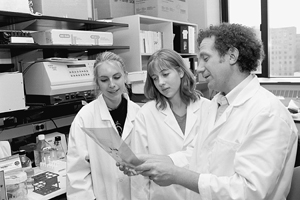By Mary Beth Reilly
Health System Public Relations

Several years ago, a Chinese patient in the United States awoke from major stomach surgery to find that a feeding tube had been inserted into his small intestine. He insisted that the tube be removed, and then checked himself out of the hospital and flew home to China weeks before his doctors felt he was strong enough. Had the patient been asked in advance, he would have informed his surgeon that a foreign object connected to his body was culturally unacceptable; he and the surgeon could then have discussed options.
What the patient’s surgeon learned from this particular incident is something now shared with second-year medical students at the Medical School. He had neglected to explore the patient’s culture and the ways in which major surgery and post-operative procedures might conflict with cultural beliefs and practices. The outcomes could have been deadly.
“This story, and follow-up discussions in small groups of medical students facilitated by clinical faculty, is one introductory component of the Medical School’s new Program for Integrated Medical Education and Patient Health designed to help students learn how to approach, communicate with, and treat each of their patients as unique individuals,” says Joseph Fantone, associate dean for medical education and professor of pathology.
Early in their education students traditionally spend significant time in classrooms and laboratories learning enormous amounts of scientific information they later must synthesize into a human context in order to care for patients. As a result, students’ initial tendency has been to approach patients with a focus more on scientific facts and evidence than on people.
“The characteristics that make individuals unique and contribute to disease and to wellness can be too easily lost or overlooked. This new program creates a human context for the medical sciences that students are already learning,” says Fantone.
Over the last year, faculty and staff in the Medical School have received support from a number of sources to integrate patient-focused topics including multiculturalism, spirituality, complementary and alternative medicine, geriatrics, and end-of-life care into the more conventional, science-based and disease-focused curriculum for medical students. The new program, made possible through funds from the Arthur Vining Davis Foundations, the Donald W. Reynolds Foundation, and the National Institutes of Health, consolidates these efforts in a Medical School-wide curriculum that will focus learning on patients.
Faculty involved in the program are collaborating with other physician-faculty members who guide medical education at the U-M to review and refresh the curriculum. Learning about scientific principles will continue in the classrooms and laboratories, but there also will be corresponding, fully-developed patient cases designed as learning tools that will challenge students on both scientific and humanistic levels. Cases will present patients of specific ages and genders, with and without symptoms, or existing/changing conditions, along with information about socioeconomic status, families, ethnic backgrounds, cultural practices, health beliefs and sexual orientation.
Students also will be assigned to clinics in order to participate in patient care and learn how science and the human side of medical practice come together.
“This new program is in part a response to society’s needs. Today’s patients expect more enlightened health care providers, particularly in terms of awareness of the immense diversity in cultures currently represented—and growing—in the American population. The Medical School has created the Program for Integrated Medical Education and Patient Health to add yet another dimension to a curriculum that continues to provide a strong foundation in biomedical sciences, and emphasizes professionalism and communication skills,” Fantone says.

